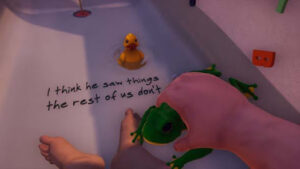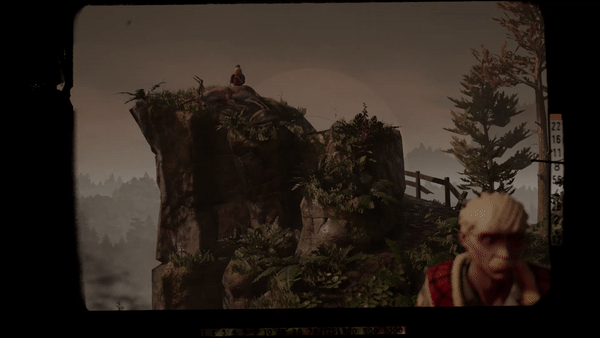
What Remains of Edith Finch was nothing short of a thoroughly depressing gaming experience. When considering a game that features death as a focal theme in its narrative, this shouldn’t be much of a surprise, however. The soundtrack (which is fantastic by the way) only compounds the profound feeling of emptiness brought about by this game’s masterful storytelling. Each isolated level is special in its own right, but the titles of my personal favorite and the best usage of game mechanics can only be granted to one each.
I would have to say that Gregory’s level was my favorite of the bunch for a few reasons, though it was a very close race. Not only were the level’s silly toy physics and logic engaging but the story here was delivered quite skillfully as well. To put it simply, it was fun to jump and swim around in the little world within Gregory’s imagination accompanied by the happy-go-lucky music choice. A bit too much fun…
The way the story is conveyed here deserves the chef’s kiss. The regret, longing, and misery in the current narrator’s voice is palpable. As soon as the child was absentmindedly left unattended in the bath tub, my jaded brain could tell exactly where this sequence was headed. I find it interesting that, while the player can easily recognize that messing with the water faucet is what will ultimately spell Gregory’s end, we also know that Gregory is just a baby, utterly oblivious to any consequences at hand yet, with this dramatic irony, the player has no choice but to commence tomfoolery if they wish to progress through the story. All of this put together creates what I believe to be one of the most tragic yet fascinating levels in this game.

(This one is stolen shamelessly from Google Images, http://www.megabearsfan.net/image.axd/2018/4/EdithFinch-Gregory_seeing.jpg)
While the goofy mechanics of this level are notable, I think the most effective use of these can be found in Lewis’ story. The gameplay starts with Lewis monotonously grabbing fish and moving them to the automatic slicer. Initially, I was worried I was gonna accidentally slice off my hand one of the times. Unfortunately, I was ultimately only partially wrong.
Over the course of the level, not only does the world within Lewis’ head become vastly more complex, but the real world becomes more and more obscured by the former until all that is left is the fish and later nothing at all. I think this mechanic is intended to represent Lewis’ progressive retreat into his own psyche over time to cope with the disinterest and misery with which he views reality. This interconnection between mechanics and narrative creates a uniquely cohesive experience among the most profound in this game.
Another thing I noticed about What Remains of Edith Finch is that (at least as far as I can remember) none of the causes of death for any of the family members are explicitly stated by the narrator in dialogue, only visually (and sometimes only implied or purposely vague). For example, Molly probably died of poisoning after consuming an entire tube of fluoride toothpaste, but the best implication we actually are delivered in game is that she died after being eaten by a monster she imagined. All we know about Barbara is that she was ultimately killed by someone and that the boyfriend is suspected. Not very concrete if you ask me. We also aren’t exactly delivered a decisive explanation as to the reason behind Lewis’ death. We know that he is decapitated by the slicer at his workplace, but the reason why is unclear. Suicide? Accidentally while falling deeper into his delusion? Both? Up for interpretation.

Sam’s silly shenanigans (this one is mine).
